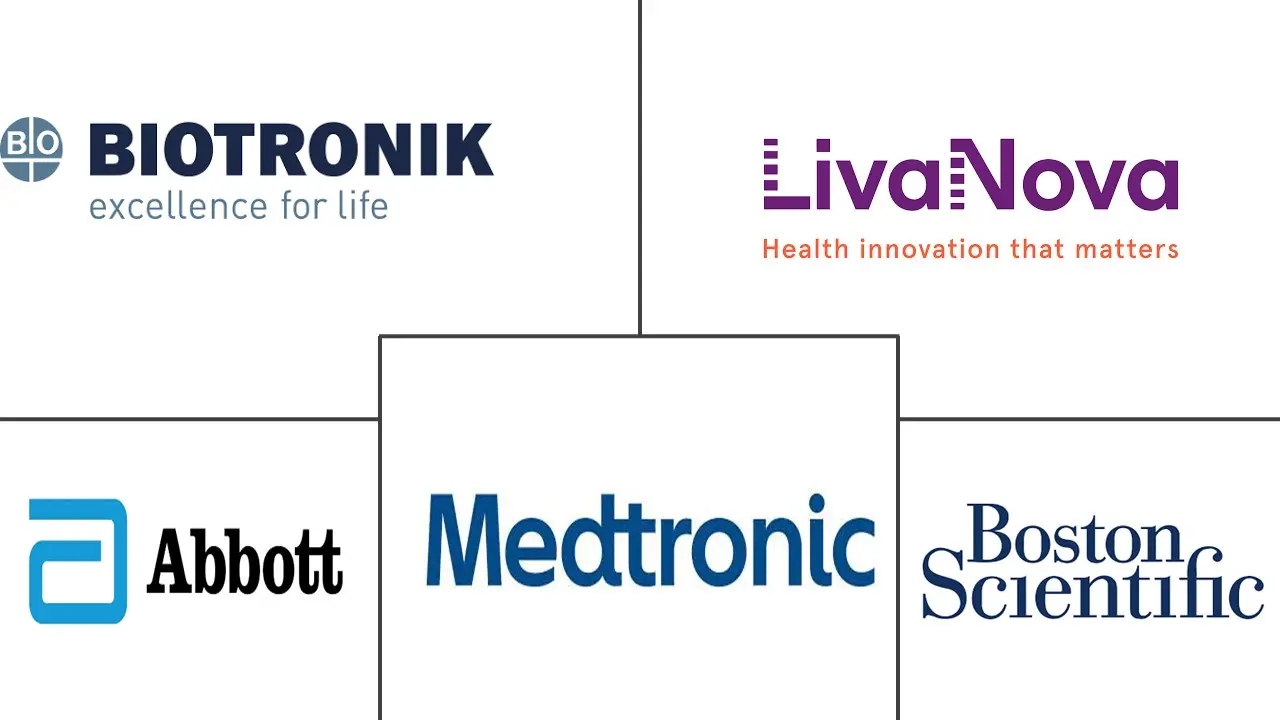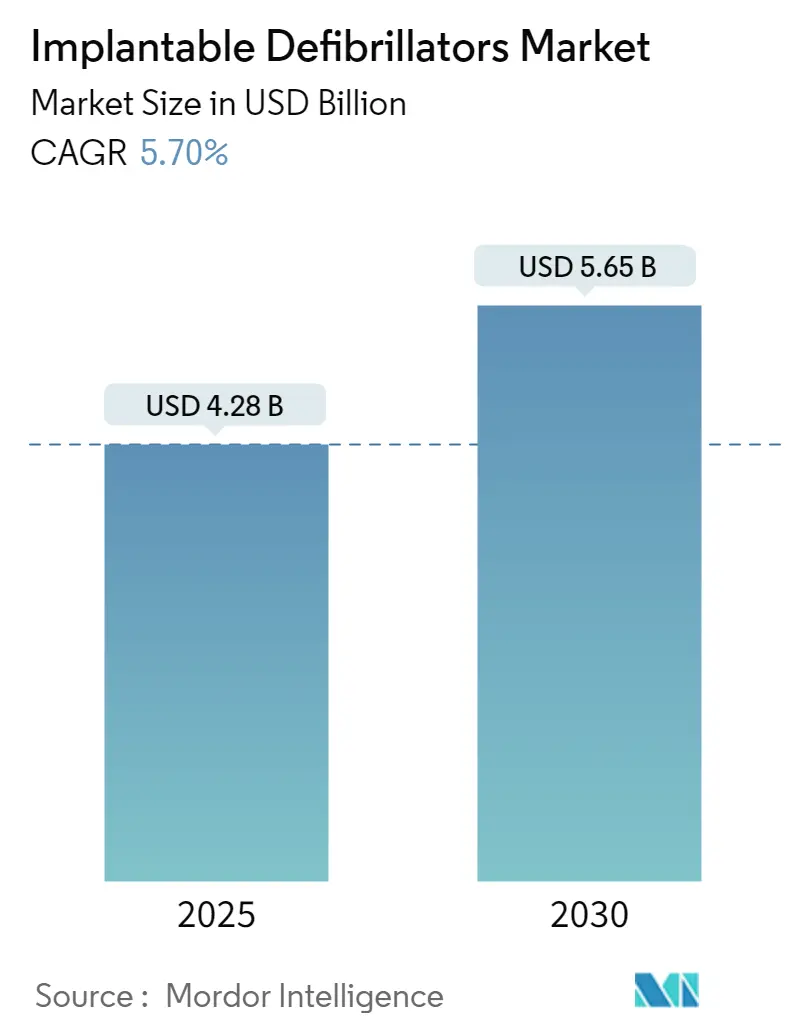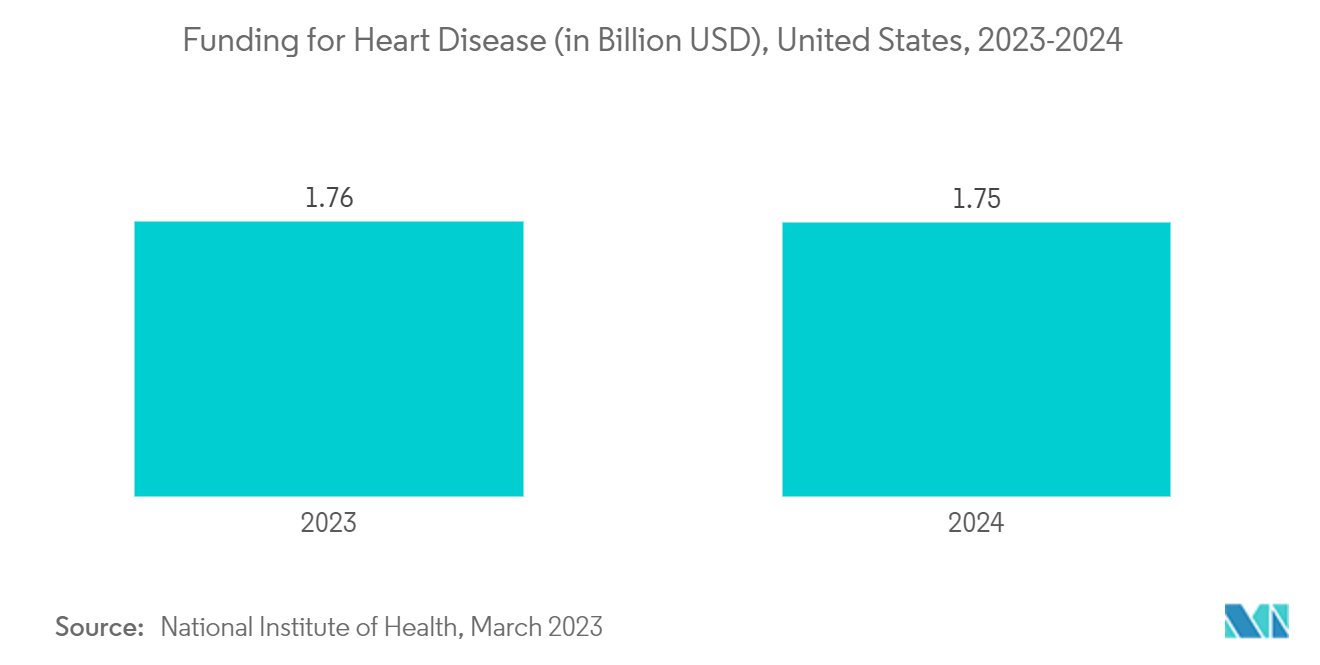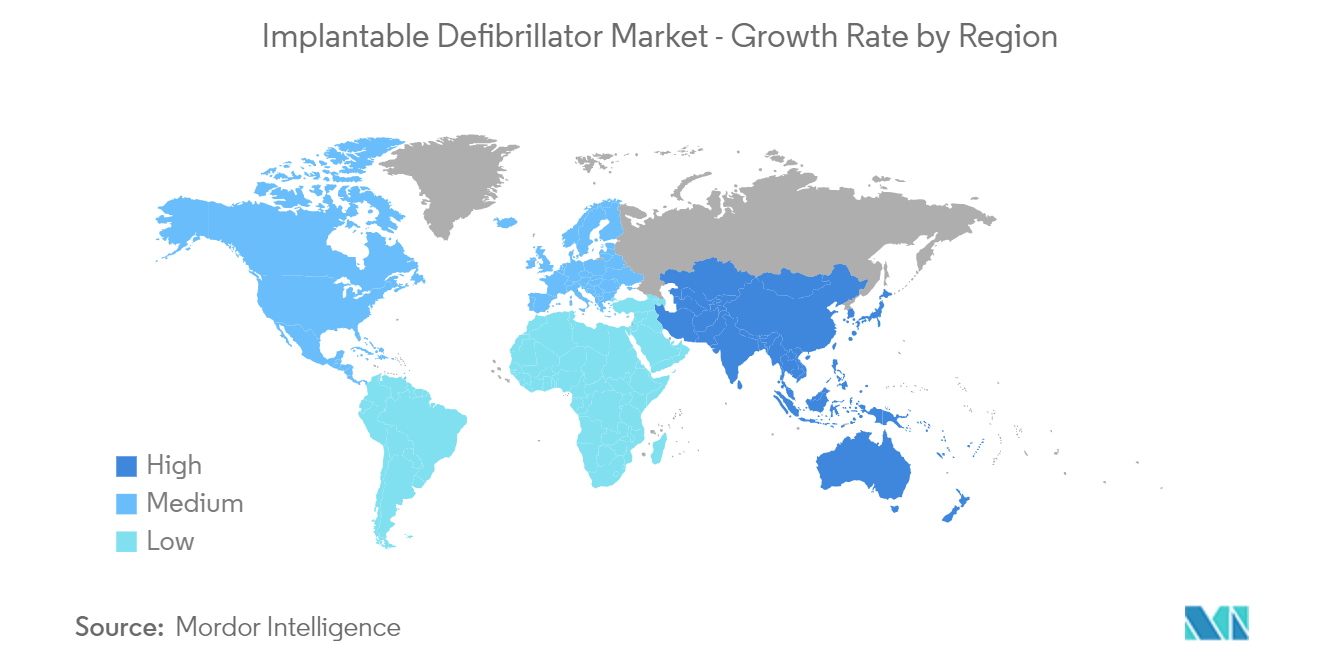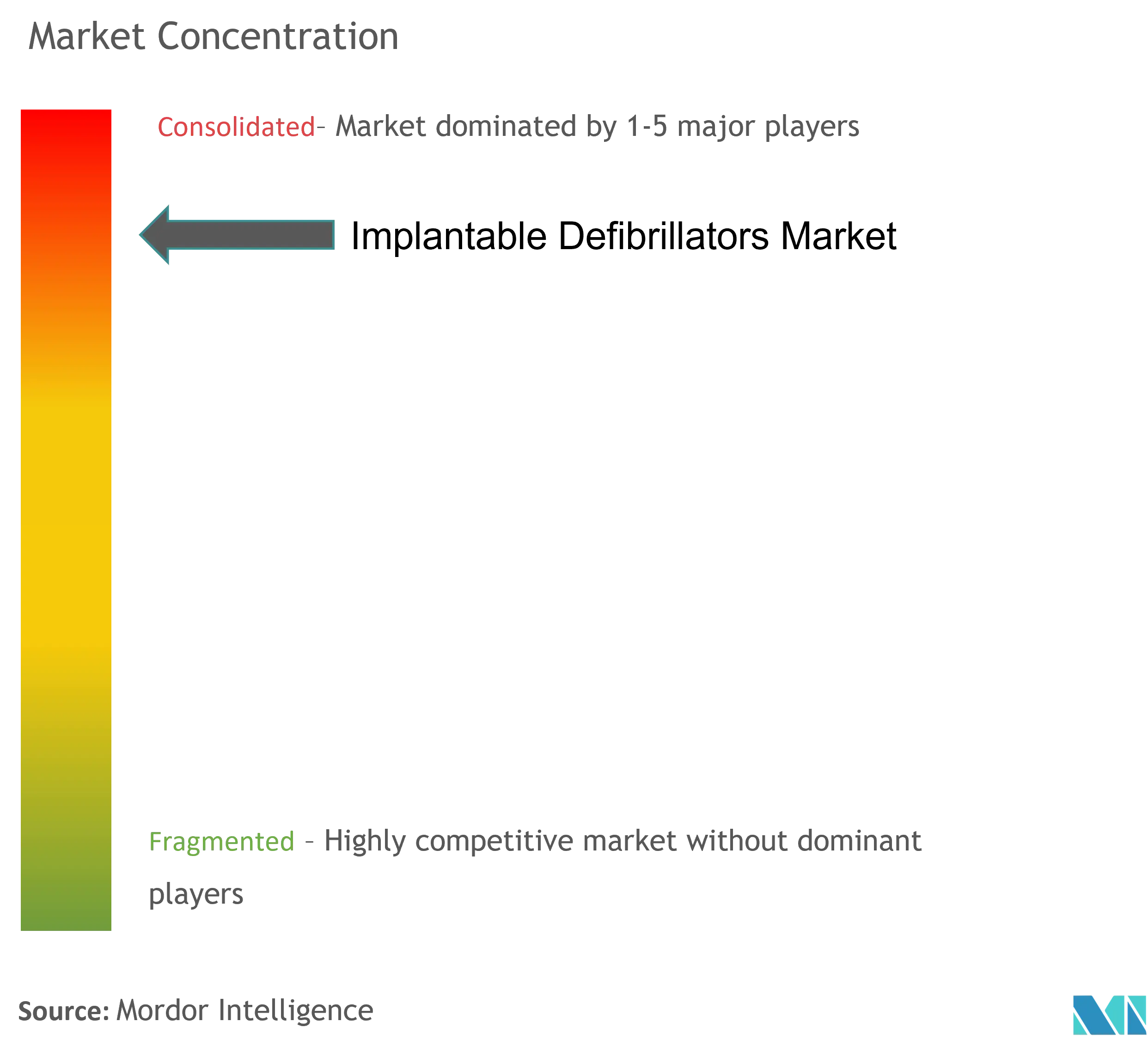Implantable Defibrillators Market Analysis
The Implantable Defibrillators Market size is estimated at USD 4.28 billion in 2025, and is expected to reach USD 5.65 billion by 2030, at a CAGR of 5.7% during the forecast period (2025-2030).
COVID-19 significantly impacted the implantable defibrillator market during the pandemic due to the rise in cardiac arrest among COVID-19 patients. The market declined during the initial pandemic but increased due to the demand for implantable defibrillators in COVID-19 patients. For instance, according to the study published in the Journal of Cardiac Failure in June 2022, implantable cardioverter defibrillators (ICDs) implanted in patients with heart failure provided helpful information on markers of cardiac status such as atrial fibrillation (AF). Thus, it was expected to increase adoption of implantable defibrillators during the COVID-19 pandemic, thereby driving market growth during the late pandemic.
The factors driving the growth of the implantable defibrillators market include the increasing prevalence of cardiac arrhythmias such as ventricular fibrillation, ventricular tachycardia, and other heart diseases such as myocardial infarction or congenital heart diseases.
The rising prevalence of heart diseases such as heart failure is anticipated to drive market growth. For instance, according to the American Heart Association's annual report in 2022, the prevalence rate of heart failure in the United States was around 6 million in 2021, accounting for 1.8% of the total population. Furthermore, according to the Centers for Disease Control and Prevention, in July 2023, the percentage of adults aged 18 and over living with myocardial infarction in the United States in 2022 was 3% of the total population. Such a massive prevalence of myocardial infarction is anticipated to increase the adoption of implantable defibrillators, driving market growth.
In addition, according to the British Heart Foundation, in August 2022, around 7.6 million people in the United Kindom suffered from heart and circulatory diseases 2022. The massive prevalence of cardiovascular disease in developed countries such as the United Kingdom escalates the demand for implantable defibrillators, fueling the target market growth in the studied period.
The rising technological advancements and improved success rates of implantable defibrillators in recent years are anticipated to boost market growth further. For instance, in August 2022, clinical research presented by Medtronic PLC demonstrated the effectiveness of a novel minimally invasive defibrillator implant (Medtronic EV ICD system) intended to stop a sudden cardiac arrest. The extravascular implantable defibrillator system, which includes its primary component under the left armpit, offers backup pacing therapy to reduce vibrations, prevent tachycardia, and help patients avoid defibrillation shock.
Therefore, the increasing prevalence of cardiac arrhythmia and other heart diseases is expected to increase the demand for implantable defibrillators for early access to cardiac arrest. It is further expected to boost the growth of the studied market over the forecast period. However, the stringent regulatory framework for implantable defibrillators is anticipated to impede market growth.
Implantable Defibrillators Market Trends
Subcutaneous Implantable Cardioverter Defibrillator (S-ICD) is Anticipated to Show the Fastest Growth Over the Forecast Period.
The Subcutaneous Implantable Cardioverter Defibrillator (S-ICD) effectively senses, discriminates, and converts ventricular tachycardia/ventricular fibrillation using a subcutaneous electrode to analyze the heart rhythm. It is an established therapy for preventing sudden cardiac death and an alternative to a transvenous implantable cardioverter-defibrillator (ICD) system in selected patients.
The factors driving the segment's growth include the rising initiatives from the key market players and the increasing awareness of S-ICD among people.
Key market players are constantly working to identify the safety and effectiveness of subcutaneous implantable defibrillators, which are anticipated to drive segment growth. For instance, in December 2021, Boston Scientific Corporation conducted a study on S-ICD to assess the subcutaneous implantable defibrillator's efficacy, performance, and safety. The findings suggested that the S-ICD system prevents many difficulties connected with leads inserted in those locations because it offers protection without touching the heart or substernal area.
Furthermore, the various advantages of subcutaneous implantable defibrillators are anticipated to propel segment growth. For instance, according to the study published in the Arrhythmia & Electrophysiology Review (AER) Journal in July 2021, S-ICDs help patients avoid many of the short and long-term dangers of de novo implantation, including pneumothorax and heart perforation, and systemic infection. Additionally, S-ICDs underwent multicentre clinical studies where they demonstrated their efficacy, and new findings indicated that they might even be superior to Transvenous ICDs in some circumstances. Therefore, benefits associated with subcutaneous implantable defibrillators increase the demand and drive the growth of the segment studied.
Therefore, owing to the significant benefits of subcutaneous implantable defibrillators, the segment is anticipated to grow fastest over the forecast period.
North America is Expected to Hold a Major Share of the Studied Market Over the Forecast Period
North America is expected to hold a significant share of the overall implantable defibrillators market throughout the forecast period. It is due to the high healthcare expenditures, rising awareness of ICD's effectiveness in cardiovascular disorders such as arrhythmias, flutters, and fibrillations, and the presence of major key market players in the region.
Furthermore, the United States defibrillator market is growing within North America due to rising technological advancements through partnerships and the supportive reimbursement policy. In addition, the increase in government funding for cardiovascular diseases and the increase in research and development activities, among others, will drive the adoption of implantable defibrillators in the United States, driving market growth.
The rising prevalence of cardiovascular diseases (CVD), such as arrhythmias, among the population of the United States led to increased adoption of defibrillators for proper disease management. For instance, according to the Arrhythmia Alliance Report 2023, about 1 in 50 Americans under age 65, whereas 1 in 10 Americans over age 65 suffer from atrial fibrillation annually, and around 1 in 2,100 persons experience ventricular arrhythmias in the United States annually. Therefore, the considerable incidence of arrhythmia is projected to boost the demand for implantable defibrillators, which is anticipated to drive market growth.
Moreover, the rising adoption of implantable defibrillators in the hospitals and clinics of the United States is anticipated to drive market growth in the region. For instance, in December 2021, as part of an international clinical trial, Cleveland Clinic successfully implanted leadless pacemaker defibrillator systems in the first two patients in the world. The innovative device, which promises to provide treatment for low and increased heart rates, combines the technology of a leadless pacemaker with a subcutaneous implantable cardioverter defibrillator.
Therefore, the rising adoption of implantable defibrillators and the increasing prevalence of cardiac rhythm disorders in the region is anticipated to drive market growth.
Implantable Defibrillators Industry Overview
The market for implantable defibrillators is highly consolidated with established market players. The factors owing to the competition include the rising research and development on implantable defibrillators, rising approvals from regulatory agencies, and the key initiatives adopted by the market players. Some players operating in the market include Boston Scientific Corporation, Microport Scientific Corporation, Medtronic PLC, Abbott, and Biotronik, among others.
Implantable Defibrillators Market Leaders
-
Boston Scientific Corporation
-
Medtronic PLC
-
LivaNova PLC
-
Abbott
-
Biotronik
- *Disclaimer: Major Players sorted in no particular order
Implantable Defibrillators Market News
- May 2023: Medtronic PLC released the longer-term follow-up results of its investigational extravascular implantable cardioverter defibrillator (EV ICD) System. It is designed to treat irregular heart rhythms that can lead to sudden cardiac arrest. The EV ICD system is investigational and not yet approved for sale or distribution in the United States.
- February 2023: Medtronic PLC received the CE mark for the Aurora EV-ICD MRI SureScan (Extravascular Implantable Cardioverter-Defibrillator) and Epsila EV MRI SureScan defibrillation lead to treat very fast heart rhythms that can result in sudden cardiac arrest.
Implantable Defibrillators Industry Segmentation
Implantable Defibrillator/Implantable Cardioverter Defibrillator (ICD) is a battery-powered device placed under the skin that connects the ICD to the patient's heart using thin wires. The ICD keeps track of the heart rate, and if an abnormal heart rhythm is detected, the device will deliver an electric shock to restore a normal heartbeat. The Implantable Defibrillators Market is segmented by type (single chambered, dual chambered, and biventricular), route (transvenous/traditional ICD and Subcutaneous (S-ICD)), end user (hospitals, specialty clinics, and ambulatory surgical centers) and Geography (North America, Europe, Asia-Pacific, Middle East and Africa, and South America). The report also covers the estimated market sizes and trends for 17 countries across major regions globally. The report offers the value (in USD) for the above segments.
| By Type | Singel Chambered | ||
| Dual Chambered | |||
| Biventricular (cardiac resynchronization therapy) | |||
| By Route | Transvenous/Traditional ICD | ||
| Subcutaneous (S-ICD) | |||
| By End User | Hospitals | ||
| Speciality Clinics | |||
| Ambulatory Surgical Centers | |||
| Geography | North America | United States | |
| Canada | |||
| Mexico | |||
| Europe | Germany | ||
| United Kingdom | |||
| France | |||
| Italy | |||
| Spain | |||
| Rest of Europe | |||
| Asia-Pacific | China | ||
| Japan | |||
| India | |||
| Australia | |||
| South Korea | |||
| Rest of Asia-Pacific | |||
| Middle East and Africa | GCC | ||
| South Africa | |||
| Rest of Middle East and Africa | |||
| South America | Brazil | ||
| Argentina | |||
| Rest of South America | |||
Implantable Defibrillators Market Research Faqs
How big is the Implantable Defibrillators Market?
The Implantable Defibrillators Market size is expected to reach USD 4.28 billion in 2025 and grow at a CAGR of 5.70% to reach USD 5.65 billion by 2030.
What is the current Implantable Defibrillators Market size?
In 2025, the Implantable Defibrillators Market size is expected to reach USD 4.28 billion.
Who are the key players in Implantable Defibrillators Market?
Boston Scientific Corporation, Medtronic PLC, LivaNova PLC, Abbott and Biotronik are the major companies operating in the Implantable Defibrillators Market.
Which is the fastest growing region in Implantable Defibrillators Market?
Asia Pacific is estimated to grow at the highest CAGR over the forecast period (2025-2030).
Which region has the biggest share in Implantable Defibrillators Market?
In 2025, the North America accounts for the largest market share in Implantable Defibrillators Market.
What years does this Implantable Defibrillators Market cover, and what was the market size in 2024?
In 2024, the Implantable Defibrillators Market size was estimated at USD 4.04 billion. The report covers the Implantable Defibrillators Market historical market size for years: 2019, 2020, 2021, 2022, 2023 and 2024. The report also forecasts the Implantable Defibrillators Market size for years: 2025, 2026, 2027, 2028, 2029 and 2030.
Our Best Selling Reports
Implantable Defibrillators Industry Report
Statistics for the 2025 Implantable Defibrillators market share, size and revenue growth rate, created by Mordor Intelligence™ Industry Reports. Implantable Defibrillators analysis includes a market forecast outlook for 2025 to 2030 and historical overview. Get a sample of this industry analysis as a free report PDF download.

